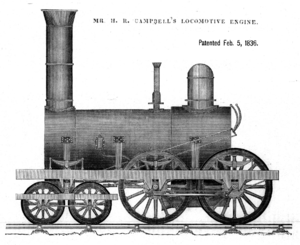
Back Lokomotivy 4-4-0 American Czech American (Lokomotive) German 4-4-0 Spanish American (locomotive) French 車輪配置 4-4-0 Japanese Locomotiva 4-4-0 Portuguese 2-2-0 Russian 2-2-0 Ukrainian
 Front of locomotive at left | |||||||||||||||||||||
 1836 Patent drawing of the first 4-4-0 locomotive | |||||||||||||||||||||
| |||||||||||||||||||||
| |||||||||||||||||||||
| |||||||||||||||||||||
4-4-0, in the Whyte notation, denotes a steam locomotive with a wheel arrangement of four leading wheels on two axles (usually in a leading bogie), four powered and coupled driving wheels on two axles, and no trailing wheels.
First built in the 1830s, locomotives with this wheel arrangement were known as "standard" or "Eight-Wheeler" type. In the first half of the 19th century, almost every major railroad in North America owned and operated locomotives of this type, and many rebuilt their 4-2-0 and 2-4-0 locomotives as 4-4-0s.[1][2]
In April 1872, Railroad Gazette used "American" as the name of the type. The type subsequently also became popular in the United Kingdom, where large numbers were produced.[1]
The vast majority of 4-4-0 locomotives had tenders, though some tank locomotives (designated 4-4-0T) were built.
- ^ a b White, John H., Jr. (1968). A history of the American locomotive; its development: 1830-1880. New York: Dover Publications, pp. 46-. ISBN 0-486-23818-0
- ^ Kinert, Reed. (1962). Early American steam locomotives; 1st seven decades: 1830-1900. Seattle, WA: Superior Publishing Company.